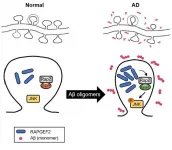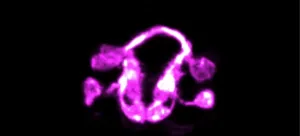Uncovers the molecular mechanism behind synapse loss in Alzheimer's disease
Molecular mechanisms of synaptic damage can point way to new treatment approaches
2021-02-24
(Press-News.org) Korea Brain Research Institute (KBRI, Pann-Ghill Suh (President)) announced that Dr. Kea Joo Lee and Dr. You-Na Jang of the Neural Circuits Research Group have identified the mechanism causing synaptic loss in Alzheimer's disease as the aberrant expression of RAPGEF2, a synaptic protein.
- The results were published on January 2021, in the online Early View of Neuropathology and Applied Neurobiology.
* (Title) RAPGEF2 mediates oligomeric Aβ-induced synaptic loss and cognitive dysfunction in the 3xTg-AD mouse model of Alzheimer's disease
Alzheimer's disease (AD) accounts for about 75% of dementia cases and is the most common type of degenerative brain disease. AD is a devastating because disease progression can cause memory loss, mood disorder, slurred speech, confusion, and impaired movement.
- With the conventional treatment available today, AD patients may expect to see some temporary improvement of symptoms, but nothing exists at the moment that can halt or reverse the progression. Instead, preventive strategies are emphasized, with health care professionals commonly suggesting physical exercise and continued learning programs as options.
- AD is a tricky condition that has constantly thwarted the best efforts to unravel the inner workings of the disease. In the leading hypothesis, abnormal aggregation of amyloid beta (Aß) and tau proteins are identified as a possible cause of the illness. Amyloid beta is known to degrade synapses and drive cognitive impairment such as memory loss.
In their work unveiling the complex processes by which amyloid beta brings about synaptic loss, Dr. Kea Joo Lee and his team have been studying the brain tissue of both deceased Alzheimer's patients and genetically modified mouse models for the disease, and have found "RAPGEF2 protein overexpression" to be the common phenomenon.
* RAPGEF2(Rap guanin nucleotide exchange factor 2) is an essential protein involved in multiple critical biological pathways such as synaptic remodeling, neural plasticity, and embryo neural development
- Employing various neurobiological methodologies that utilize neuronal cell culture models and brain tissue from mouse models of Alzheimer's, the researchers arrived at the conclusion that "amyloid beta facilitates the overexpression of the RAPGEF2 protein," and "the RAPGEF2 protein, in turn, activates downstream effectors RAP2 and JNK to ultimately induce synaptic loss."
- Intriguingly, electron microscopy and behavioral tests conducted by the team showed the silencing of RAPGEF2 as having a preventive effect on synapse loss and cognitive impairment even in the presence of increased amyloid beta.
The potential significance of these findings is great. Having a detailed understanding of the molecular mechanisms behind synaptic damage that occurs in the early stages of the Alzheimer's disease can be invaluable in developing treatments for neurodegenerative diseases such as dementia which have continued to plague humanity despite scientific advancement.
INFORMATION:
This research was supported by grants from the National Research Foundation of Korea, and the Korea Brain Research Institute (KBRI) basic research program.
[Attachments] See images for this press release:

ELSE PRESS RELEASES FROM THIS DATE:
2021-02-24
Chemical & Engineering News (C&EN), the newsmagazine of the American Chemical Society (ACS), is celebrating Black chemists and chemical engineers with a special issue highlighting Black chemists who work across the fields of biotechnology, solar energy, pharmaceuticals and more. Guest edited by Massachusetts Institute of Technology (MIT) drug delivery pioneer Paula Hammond, Ph.D., this special issue showcases Black scientists, spotlighting their scientific passions and career accomplishments.
"In bringing into focus the unique lives of this set of accomplished Black scientists in chemistry and chemical engineering, ...
2021-02-24
The steadily increasing prevalence and high costs of treating chronic joint pain worldwide poses a challenge for healthcare systems and healthcare payers. New research published today in END ...
2021-02-24
The family of ENDOU enzymes is found in most organisms, yet its functions are only poorly understood. In humans, it has been connected with cancer. RNA viruses, such as SARS-CoV2, contain a gene corresponding to ENDOU, and this is important for virus replication and the suppression of the immune response. However, so far only few details of the role of these enzymes are known. The research group led by the molecular geneticist Dr. Wenjing Qi from the University of Freiburg now contributes some more details to its function in a study published by the renowned scientific journal Nature Communications. They suggest that the gene ENDU-2 could ...
2021-02-24
Responding to artificial intelligence's exploding demands on computer networks, Princeton University researchers in recent years have radically increased the speed and slashed the energy use of specialized AI systems. Now, the researchers have moved their innovation closer to widespread use by creating co-designed hardware and software that will allow designers to blend these new types of systems into their applications.
"Software is a critical part of enabling new hardware," said Naveen Verma, a professor of electrical and computer engineering at Princeton and a leader of the research team. "The ...
2021-02-24
More U.S. adults reported receiving or planning to receive an influenza vaccination during the 2020-2021 flu season than ever before, according to findings from a national survey.
The survey of 1,027 adults, conducted by the University of Georgia, found that 43.5% of respondents reported having already received a flu vaccination with an additional 13.5% stating they "definitely will get one" and 9.3% stating they "probably will get one." Combined, 66.3% have received or intend to receive an influenza vaccination.
By comparison, 48.4% of adults 18 and older received the vaccine during the 2019-2020 flu season, according to the Centers for Disease ...
2021-02-24
A new analysis of education debates on both social media and in traditional media outlets suggests that the education sector is being increasingly influenced by populism and the wider social media 'culture wars'.
The study also suggests that the type of populism in question is not quite the same as that used to explain large-scale political events, such as the UK's 'Brexit' from the European Union, or Donald Trump's recent presidency in the United States.
Instead, the researchers - from the University of Cambridge, UK, and Queensland University of Technology, Australia - identify a phenomenon called 'micropopulism': a localised populism which spotlights an aspect of public ...
2021-02-24
CHICAGO, February 24, 2021 -- Despite having been designated as high risk for COVID-19 by the Occupational Safety and Health Administration, a new study finds 3.1 percent of dental hygienists have had COVID-19 based on data collected in October 2020. This is in alignment with the cumulative infection prevalence rate among dentists and far below that of other health professionals in the U.S, although slightly higher than that of the general population.
The research, published by The Journal of Dental Hygiene, is the first large-scale collection and publication of U.S. dental hygienists' infection rates and infection control practices related to COVID-19. In partnership, the American Dental Hygienists' Association (ADHA) and the American Dental Association (ADA) ...
2021-02-24
The transition from single-celled organisms to multicellular ones was a major step in the evolution of complex life forms. Multicellular organisms arose hundreds of millions of years ago, but the forces underlying this event remain mysterious. To investigate the origins of multicellularity, Erika Pearce's group at the MPI of Immunobiology and Epigenetics in Freiburg turned to the slime mold Dictyostelium discoideum, which can exist in both a unicellular and a multicellular state, lying on the cusp of this key evolutionary step. These dramatically different states depend on just one thing - food.
A core question of Pearce's lab is to answer how changes in metabolism drive cell function and differentiation. Usually, they study immune cells ...
2021-02-24
People who have had evidence of a prior infection with SARS-CoV-2, the virus that causes COVID-19, appear to be well protected against being reinfected with the virus, at least for a few months, according to a newly published study from the National Cancer Institute (NCI). This finding may explain why reinfection appears to be relatively rare, and it could have important public health implications, including decisions about returning to physical workplaces, school attendance, the prioritization of vaccine distribution, and other activities.
For the study, researchers at NCI, part of the National Institutes of Health, collaborated with ...
2021-02-24
The formation of a brain is one of nature's most staggeringly complex accomplishments. The intricate intermingling of neurons and a labyrinth of connections also make it a particularly difficult feat for scientists to study.
Now, Yale researchers and collaborators have devised a strategy that allows them to see this previously impenetrable process unfold in a living animal -- the worm Caenorhabditis elegans, they report February 24 in the journal Nature.
"Before, we were able to study single cells, or small groups of cells, in the context of the living C. elegans, and for relatively short periods of time," said Mark Moyle, an associate research scientist in neuroscience at Yale School of Medicine and first author of the study. "It has been a breathtaking experience to ...
LAST 30 PRESS RELEASES:
[Press-News.org] Uncovers the molecular mechanism behind synapse loss in Alzheimer's disease
Molecular mechanisms of synaptic damage can point way to new treatment approaches






